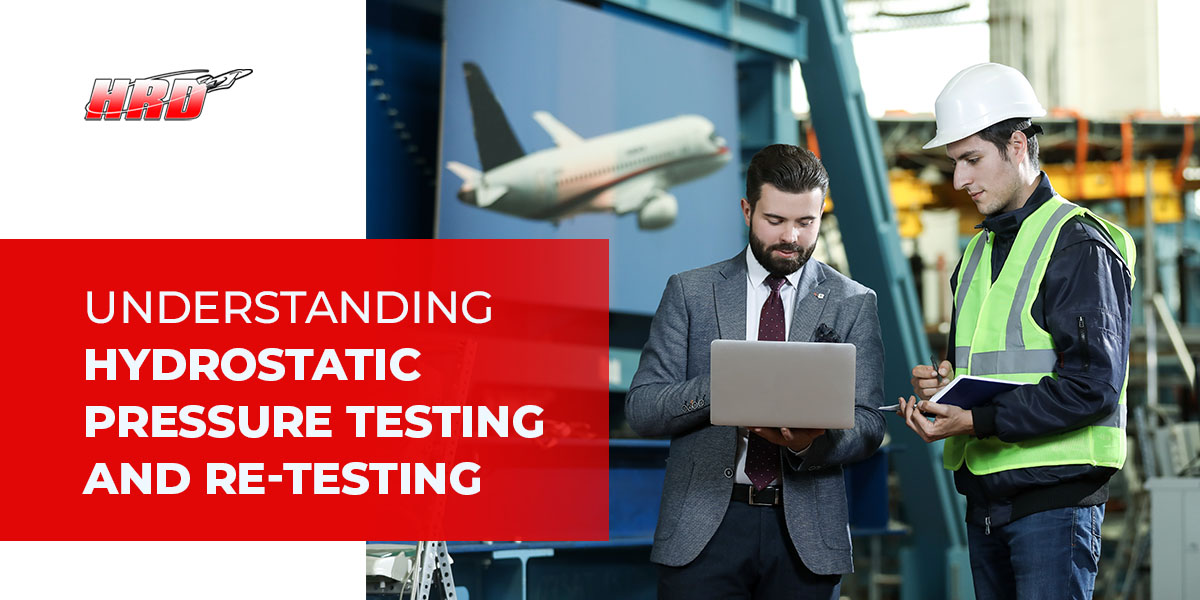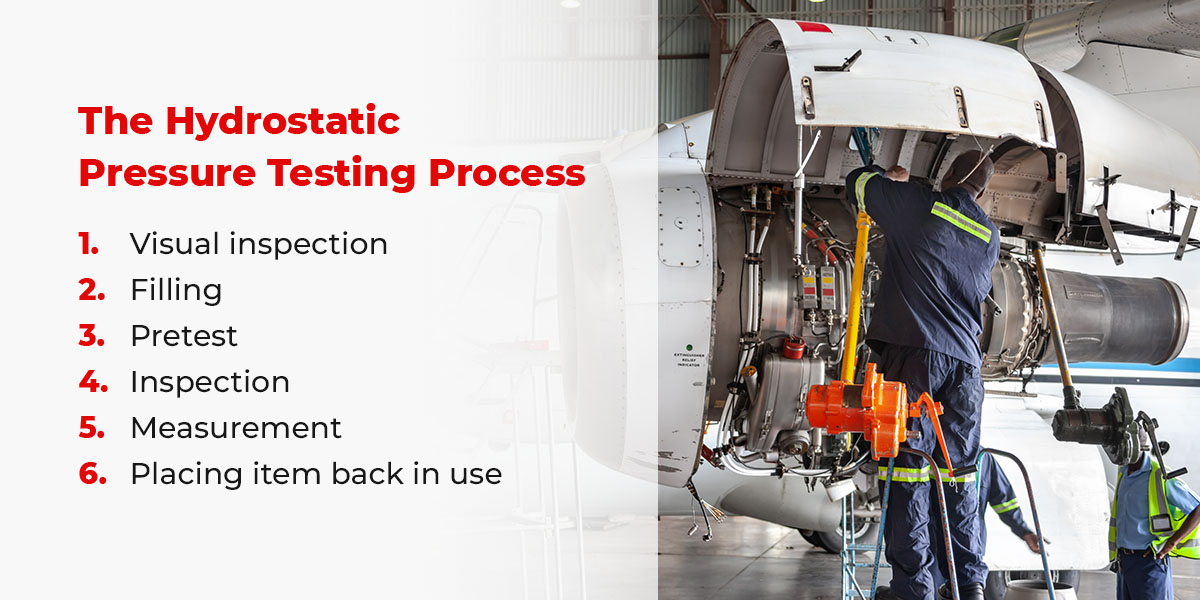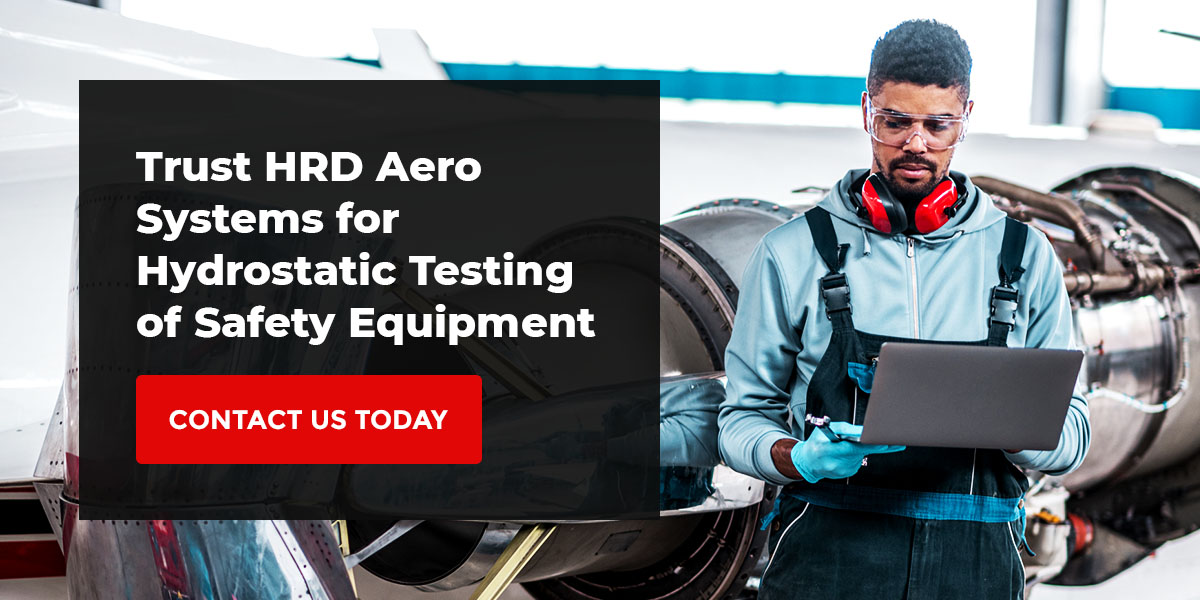
Safety is paramount in the aviation industry, whether it’s practicing evacuation procedures or having working safety equipment on board. Airplanes carry specialized equipment to mitigate risks and assist passengers and crew members in emergencies, and these tools require routine service and maintenance to keep working.
For example, fire extinguishers, oxygen cylinders, and inflatable cylinders undergo hydrostatic pressure re-testing to ensure the pressure vessel is ready for transportation, storage, and operation.
What Is Hydrostatic Pressure Re-testing?
Hydrostatic pressure testing involves filling a vessel or component with a non-compressible liquid, usually water, and pressurizing it to a specified test pressure which typically exceeds the normal operational pressure level. This pressure is held for a specific amount of time to observe the test subject for leaks, permanent expansion, or any catastrophic failure.
Testing vs. Re-testing. From the Original Equipment Manufacturer (OEM), the vessel undergoes its initial hydrostatic test. It is then stamped with the manufacturer’s RIN number. Every test after the initial hydrostatic test is considered a re-test and also requires the DOT-approved facility to stamp or label its RIN number in specific places on the unit.
The Importance of Hydrostatic Testing in Aircraft Safety Equipment
Hydrostatic testing is necessary to determine whether a pressure vessel can hold its rated pressure. Any flaws could threaten everyone on when in service on an aircraft, stored on a shelf, or transported in a vehicle.
The benefits of hydrostatic pressure testing include:
- Ensuring vessel integrity for transportation, storage, and service
- Compliance with DOT regulations
The Hydrostatic Pressure Testing Process
Technicians only run hydrostatic pressure testing when equipment is not in use. They usually run these tests to validate that everything works without any problems. Even though hydrostatic pressure testing is a non-destructive — or non-invasive — testing technique, it’s best left to skilled professionals to avoid safety incidents.
The procedure may differ slightly depending on the equipment or vessels undergoing the test, but the general process follows these steps.
- Visual inspection: Professionals check the exteriors for anything that could compromise them, from dents to corrosion. Components are inspected for physical damage and cleaned to remove any residues or contaminants that could affect the results.
- Filling: The component is filled with water, ensuring all air is expelled, since air compressibility can affect test accuracy.
- Pretest: Water is then pressurized to 80% of the required test pressure, this is to ensure no equipment failures, as more than two tests at 100% test pressure can result in a rejected vessel.
- Inspection: The vessel is pressurized up to 1.5 times its usual operating pressure and holds it for a specific period per DOT standards. The technician is verifying any leaks, deformation, and sustained pressure.
- Measurement: Professionals note any permanent expansion and verify it’s within acceptable limits per the DOT Special Permit.
- Placing item back in use: If the test does not detect any abnormalities and meets the required specs, the technician stamps the cylinder with the DOT-designated RIN number and puts the vessel back into use.
Hydrostatic Pressure Testing in the Aviation Industry
The DOT and the Federal Aviation Administration (FAA) provide specific guidelines for the frequency and methodology of hydrostatic tests. For example, aircraft gas cylinders must undergo testing every three to five years. The testing standards ensure that all components can handle the maximum allowable working pressure plus a safety margin.
Inspection during testing is meticulous, focusing on:
Leak detection: Any signs of weeping or dripping are noted, as they indicate potential failure points.
Structural integrity: Components are checked for swelling, bulging, or other deformations.
Pressure sustainability: The ability of the component to hold pressure without significant loss is recorded, as any drop may suggest issues with the material or assembly.
Hydrostatic Testing for Fire Extinguishers
Fire extinguishers in aircraft are subjected to hydrostatic testing to ensure they will operate safely in the event of a fire. According to the DOT’s fire extinguisher hydrostatic testing requirements, these cylinders need re-hydrostatic testing every five years, to check for corrosion, wall thickness, and structural integrity. For portable fire extinguishers, a visual inspection is necessary every six years, and hydrostatic testing at least every 12 years.
Hydrostatic Testing for Oxygen Cylinders
Oxygen systems have many working components, but the gas cylinder is one of the most crucial parts. Since oxygen cylinders are also under pressure, the DOT also requires oxygen systems to undergo hydrostatic testing regularly to continue operating under high-pressure aircraft conditions.
Various cylinders have different testing frequencies per regulations.
- 3HT cylinders: Once every three years.
- Composite cylinders: Once every three years.
- 3AA cylinders: Once every five years.
Hydrostatic oxygen cylinder testing can ensure your equipment won’t let you down when you need it most in high altitudes.
Hydrostatic Testing for Inflatable Cylinders
Emergency inflatable cylinders, which deploy slides during an emergency evacuation, or rafts and helicopter floats during a water emergency, also require hydrostatic testing. These are typically tested every 3 years per DOT Special Permit requirements. Composite cylinders are most common, however, there are steel cylinders for different manufacturers.
Trust HRD Aero Systems for Hydrostatic Testing of Safety Equipment
It’s crucial to adhere to DOT safety and regulations to keep your aircraft compliant and maintain the safety of everyone on an airplane. Routine testing and servicing for aircraft safety equipment will keep everyone free from harm and protect lives. Since hydrostatic testing is such a delicate procedure, it’s best to entrust it to industry experts who understand and value high safety standards.
For more information on how these procedures work at HRD Aero Systems, get in touch with our team today, and one of our experts will contact you.


